Chapter 10 PDF

| Title | Chapter 10 |
|---|---|
| Author | 吉芳 章 |
| Course | Marketing Management |
| Institution | 香港中文大學 |
| Pages | 47 |
| File Size | 286.7 KB |
| File Type | |
| Total Downloads | 15 |
| Total Views | 352 |
Summary
Principles of Marketing, 16e (Kotler) Chapter 10 Pricing: Understanding and Capturing Customer Value 1) ________ refers to the amount of money charged for a product or service. A) Value B) Cost C) Price D) Wage E) Salary Answer: C Skill: Concept Objective: LO 10: Answer the question &quo...
Description
Principles of Marketing, 16e (Kotler) Chapter 10 Pricing: Understanding and Capturing Customer Value 1) ________ refers to the amount of money charged for a product or service. A) Value B) Cost C) Price D) Wage E) Salary Answer: C Skill: Concept Objective: LO 10.1: Answer the question "What is a price?" and discuss the importance of pricing in today's fast-changing environment. Difficulty: Easy 2) ________ is the only element in the marketing mix that produces revenue. A) Price B) Product C) Place D) Fixed costs E) Variable costs Answer: A Skill: Concept Objective: LO 10.1: Answer the question "What is a price?" and discuss the importance of pricing in today's fast-changing environment. Difficulty: Easy 3) Which of the following is true with regard to price? A) Historically, price has had the least perceptible impact on buyer choice. B) Price is the least flexible element in the marketing mix. C) Unlike product features and channel commitments, prices cannot be changed quickly. D) Price is the sum of all the values that customers give up to gain the benefits of having a product. E) Prices only have an indirect impact on a firm's bottom line. Answer: D AACSB: Analytical thinking Skill: Concept Objective: LO 10.1: Answer the question "What is a price?" and discuss the importance of pricing in today's fast-changing environment. Difficulty: Moderate
1 Copyright © 2016 Pearson Education, Inc.
4) Prices have a direct impact on a firm's bottom line. Answer: TRUE AACSB: Application of knowledge Skill: Concept Objective: LO 10.1: Answer the question "What is a price?" and discuss the importance of pricing in today's fast-changing environment. Difficulty: Easy 5) List some important characteristics of price. Answer: Price is the only element in the marketing mix that produces revenue; all other elements represent costs. Price is also one of the most flexible marketing mix elements. Unlike product features and channel commitments, prices can be changed quickly. AACSB: Application of knowledge; Written and oral communication Skill: Concept Objective: LO 10.1: Answer the question "What is a price?" and discuss the importance of pricing in today's fast-changing environment. Difficulty: Moderate 6) Why is price considered one of the most flexible elements of the marketing mix? Answer: Unlike product features and channel commitments, prices can be changed quickly. AACSB: Application of knowledge Skill: Concept Objective: LO 10.1: Answer the question "What is a price?" and discuss the importance of pricing in today's fast-changing environment. Difficulty: Easy
2 Copyright © 2016 Pearson Education, Inc.
7) Define price. Discuss its importance. Answer: In the narrowest sense, price is the amount of money charged for a product or a service. More broadly, price is the sum of all the values that customers give up to gain the benefits of having or using a product or service. Historically, price has been the major factor affecting buyer choice. In recent decades, however, nonprice factors have gained increasing importance. Even so, price remains one of the most important elements that determines a firm's market share and profitability. Price is the only element in the marketing mix that produces revenue; all other elements represent costs. Price is also one of the most flexible marketing mix elements. Unlike product features and channel commitments, prices can be changed quickly. At the same time, pricing is the number one problem facing many marketing executives, and many companies do not handle pricing well. Some managers view pricing as a big headache, preferring instead to focus on other marketing mix elements. However, smart managers treat pricing as a key strategic tool for creating and capturing customer value. Prices have a direct impact on a firm's bottom line. A small percentage improvement in price can generate a large percentage increase in profitability. More important, as part of a company's overall value proposition, price plays a key role in creating customer value and building customer relationships. AACSB: Analytical thinking; Written and oral communications Skill: Concept Objective: LO 10.1: Answer the question "What is a price?" and discuss the importance of pricing in today's fast-changing environment. Difficulty: Moderate 8) What sets the ceiling for product prices? A) product manufacturing costs B) sellers' perceptions of the product's value C) customer perceptions of the product's value D) variable costs E) break-even volume Answer: C AACSB: Analytical thinking Skill: Concept Objective: LO 10.2: Identify the three major pricing strategies and discuss the importance of understanding customer-value perceptions, company costs, and competitor strategies when setting prices. Difficulty: Easy
3 Copyright © 2016 Pearson Education, Inc.
9) What sets the floor for product prices? A) consumer perceptions of the product's value B) product costs C) competitors' strategies D) advertising budgets E) market competition Answer: B AACSB: Analytical thinking Skill: Concept Objective: LO 10.2: Identify the three major pricing strategies and discuss the importance of understanding customer-value perceptions, company costs, and competitor strategies when setting prices. Difficulty: Easy 10) Effective ________ pricing involves understanding how much value consumers place on the benefits they receive from the product and setting a price that captures that value. A) competition-oriented B) cost-based C) time-based D) customer-oriented E) marketer-oriented Answer: D AACSB: Analytical thinking Skill: Concept Objective: LO 10.2: Identify the three major pricing strategies and discuss the importance of understanding customer-value perceptions, company costs, and competitor strategies when setting prices. Difficulty: Easy 11) ________ pricing uses buyers' perceptions of value as the key to pricing. A) Customer value-based B) Cost-based C) Time-based D) Markup E) Target return Answer: A Skill: Concept Objective: LO 10.2: Identify the three major pricing strategies and discuss the importance of understanding customer-value perceptions, company costs, and competitor strategies when setting prices. Difficulty: Easy
4 Copyright © 2016 Pearson Education, Inc.
12) Which of the following is true of value-based pricing? A) The targeted value and price drive decisions about what costs can be incurred and the resulting product design. B) Value-based pricing is mostly product driven. C) Value-based pricing involves setting prices based on the costs of producing, distributing, and selling the product plus a fair rate of return for its effort and risk. D) The marketer usually designs a product and marketing program and then sets the price. E) A company using value-based pricing designs what it considers to be a good product, adds up the costs of making the product, and sets a price that covers costs plus a target profit. Answer: A AACSB: Analytical thinking Skill: Concept Objective: LO 10.2: Identify the three major pricing strategies and discuss the importance of understanding customer-value perceptions, company costs, and competitor strategies when setting prices. Difficulty: Moderate 13) Which of the following processes does value-based pricing reverse? A) high-low pricing B) everyday low pricing C) cost-based pricing D) good-value pricing E) value-added pricing Answer: C AACSB: Analytical thinking Skill: Concept Objective: LO 10.2: Identify the three major pricing strategies and discuss the importance of understanding customer-value perceptions, company costs, and competitor strategies when setting prices. Difficulty: Easy
5 Copyright © 2016 Pearson Education, Inc.
14) A pharmaceutical company in Utah recently released a new and expensive anti-ulcer drug in the market. The company justifies the high price of the drug by claiming that it is highly effective for treating all kinds of ulcers. The company also claims that the new drug will help bring down the need for invasive surgeries, an additional benefit for patients. Which of the following pricing strategies is the pharmaceutical company most likely using in this instance? A) target pricing B) markup pricing C) cost-based pricing D) value-based pricing E) break-even pricing Answer: D AACSB: Analytical thinking Skill: Application Objective: LO 10.2: Identify the three major pricing strategies and discuss the importance of understanding customer-value perceptions, company costs, and competitor strategies when setting prices. Difficulty: Challenging 15) The perceived value of different product offers can be reasonably assessed by ________. A) conducting a SWOT analysis B) preparing demand curves C) conducting surveys and experiments D) collecting data about competitors' offers E) setting a benchmark for product quality Answer: C AACSB: Analytical thinking Skill: Concept Objective: LO 10.2: Identify the three major pricing strategies and discuss the importance of understanding customer-value perceptions, company costs, and competitor strategies when setting prices. Difficulty: Easy 16) Underpriced products ________. A) produce less revenue than they would if they were priced at the level of perceived value B) sell poorly in the global marketplace C) produce more revenue than they would if they were priced at the level of perceived value D) mostly offer higher value than those with a high markup price E) are characterized by rapidly declining demand Answer: A AACSB: Analytical thinking Skill: Concept Objective: LO 10.2: Identify the three major pricing strategies and discuss the importance of understanding customer-value perceptions, company costs, and competitor strategies when setting prices. Difficulty: Easy
6 Copyright © 2016 Pearson Education, Inc.
17) Which of the following involves introducing less-expensive versions of established, brand name products? A) markup pricing B) good-value pricing C) time-based pricing D) cost-based pricing E) target profit pricing Answer: B AACSB: Application of knowledge Skill: Concept Objective: LO 10.2: Identify the three major pricing strategies and discuss the importance of understanding customer-value perceptions, company costs, and competitor strategies when setting prices. Difficulty: Easy 18) ________ pricing refers to offering just the right combination of quality and gratifying service at a fair price. A) Markup B) Good-value C) Cost-plus D) Target profit E) Break-even Answer: B Skill: Concept Objective: LO 10.2: Identify the three major pricing strategies and discuss the importance of understanding customer-value perceptions, company costs, and competitor strategies when setting prices. Difficulty: Easy 19) When McDonald's and other fast food restaurants offer "value menu" items at surprisingly low prices, they are most likely using ________ pricing. A) break-even B) target profit C) good-value D) cost-plus E) target return Answer: C AACSB: Application of knowledge Skill: Concept Objective: LO 10.2: Identify the three major pricing strategies and discuss the importance of understanding customer-value perceptions, company costs, and competitor strategies when setting prices. Difficulty: Easy
7 Copyright © 2016 Pearson Education, Inc.
20) Azure Air, an airline company, offers attractive prices to customers with tighter budgets. A no-frills airline, it charges for all other additional services, such as baggage handling and inflight refreshments. Which of the following best describes Azure Air's pricing method? A) target profit pricing B) good-value pricing C) cost-based pricing D) break-even pricing E) penetration pricing Answer: B AACSB: Application of knowledge Skill: Application Objective: LO 10.2: Identify the three major pricing strategies and discuss the importance of understanding customer-value perceptions, company costs, and competitor strategies when setting prices. Difficulty: Moderate 21) Retailers such as Costco and Walmart charge a constant, daily low price with few or no temporary price discounts. This is an example of ________ pricing. A) competition-based B) everyday low C) cost-plus D) break-even E) penetration Answer: B AACSB: Application of knowledge Skill: Concept Objective: LO 10.2: Identify the three major pricing strategies and discuss the importance of understanding customer-value perceptions, company costs, and competitor strategies when setting prices. Difficulty: Easy 22) Bon Vivant offers an assortment of exclusive French wines at incredibly low prices. These prices are neither limited-time offers nor special discounts, but represent the daily prices of products sold by Bon Vivant. This reflects Bon Vivant's ________ pricing strategy. A) everyday low B) markup C) penetration D) break-even E) cost-based Answer: A AACSB: Application of knowledge Skill: Application Objective: LO 10.2: Identify the three major pricing strategies and discuss the importance of understanding customer-value perceptions, company costs, and competitor strategies when setting prices. Difficulty: Moderate 8 Copyright © 2016 Pearson Education, Inc.
23) ________ pricing involves charging higher prices on an everyday basis but running frequent promotions to lower prices temporarily on selected items. A) High-low B) Everyday low C) Cost-plus D) Break-even E) Penetration Answer: A Skill: Concept Objective: LO 10.2: Identify the three major pricing strategies and discuss the importance of understanding customer-value perceptions, company costs, and competitor strategies when setting prices. Difficulty: Easy 24) Department stores such as Kohl's and Macy's practice high-low pricing by ________. A) charging a constant, everyday low price B) providing few or no temporary price discounts C) increasing prices temporarily on select products D) having frequent sale days for store credit-card holders E) underpricing most consumer items Answer: D AACSB: Analytical thinking Skill: Concept Objective: LO 10.2: Identify the three major pricing strategies and discuss the importance of understanding customer-value perceptions, company costs, and competitor strategies when setting prices. Difficulty: Moderate 25) Companies that adopt value-added pricing ________. A) consider value-added features as a fitting substitute for aggressive cost cutting B) set incredibly low prices to meet competition C) attach value-added features and services to differentiate their offers and support their higher prices D) overprice their products without any apparent justification E) underprice their products and lower quality to boost demand in the short-run Answer: C AACSB: Analytical thinking Skill: Concept Objective: LO 10.2: Identify the three major pricing strategies and discuss the importance of understanding customer-value perceptions, company costs, and competitor strategies when setting prices. Difficulty: Easy
9 Copyright © 2016 Pearson Education, Inc.
26) Which of the following is true with regard to value-added pricing? A) Companies that practice value-added pricing typically match the competition by cutting prices. B) Companies practicing value-added pricing differentiate their offers by attaching value-added features to offerings that, in turn, justify higher prices. C) The intrinsic value of products sold by companies practicing value-added pricing is far less than their actual selling price. D) Companies practicing value-added pricing primarily rely on cost differentiation. E) Value-added pricing is the most suitable pricing strategy in pure monopolies. Answer: B AACSB: Analytical thinking Skill: Concept Objective: LO 10.2: Identify the three major pricing strategies and discuss the importance of understanding customer-value perceptions, company costs, and competitor strategies when setting prices. Difficulty: Moderate 27) In an effort to differentiate its offerings from its competitors, Pegasus Computers decided to add an extra USB port in all its laptops besides providing a free pair of Delphi power bass headphones with every Pegasus laptop. Although the additional features increased the price of the laptops by $500, Pegasus was confident that the strategy would help boost demand for its laptops substantially. This is an example of ________. A) good-value pricing B) markup pricing C) break-even pricing D) value-added pricing E) cost-based pricing Answer: D AACSB: Analytical thinking Skill: Application Objective: LO 10.2: Identify the three major pricing strategies and discuss the importance of understanding customer-value perceptions, company costs, and competitor strategies when setting prices. Difficulty: Challenging
10 Copyright © 2016 Pearson Education, Inc.
28) ________ involves setting prices based on the costs for producing, distributing, and selling the product plus a fair rate of return for effort and risk. A) Value-based pricing B) Competition-based pricing C) Cost-based pricing D) Penetration pricing E) Break-even pricing Answer: C Skill: Concept Objective: LO 10.2: Identify the three major pricing strategies and discuss the importance of understanding customer-value perceptions, company costs, and competitor strategies when setting prices. Difficulty: Easy 29) Companies with lower costs ________. A) specialize in selling products with value-added features B) usually market products with inferior quality, thereby justifying the low selling price C) can set lower prices that result in smaller margins but greater sales and profits D) tend to overprice products owing to their monopolistic advantage E) usually set higher prices that result in higher margins Answer: C AACSB: Analytical thinking Skill: Concept Objective: LO 10.2: Identify the three major pricing strategies and discuss the importance of understanding customer-value perceptions, company costs, and competitor strategies when setting prices. Difficulty: Moderate 30) A company must pay each month's bills for rent, heat, interest, and executive salaries regardless of the company's level of output. This exemplifies its ________ costs. A) overhead B) variable C) target D) total E) unit Answer: A Skill: Concept Objective: LO 10.2: Identify the three major pricing strategies and discuss the importance of understanding customer-value perceptions, company costs, and competitor strategies when setting prices. Difficulty: Moderate
11 Copyright © 2016 Pearson Education, Inc.
31) Overhead costs ________ as the number of units produced increases. A) decrease B) increase steadily C) fluctuate D) remain the same E) increase rapidly Answer: D Skill: Concept Objective: LO 10.2: Identify the three major pricing strategies and discuss the importance of understanding customer-value perceptions, company costs, and competitor strategies when setting prices. Difficulty: Easy 32) Which of the following is most likely a fixed cost? A) sales representative commissions B) product distribution costs C) manufacturing input costs D) temporary worker salaries E) facility rental payments Answer: E AACSB: Analytical thinking Skill: Concept Objective: LO 10.2: Identify the three major pricing strategies and discuss the importance of understanding customer-value perceptions, company costs, and competitor strategies when setting prices. Difficulty: Easy 33) Fixed costs ________. A) are costs that do not vary with production or sales level B) vary directly with the level of production C) decrease with accumulated production experience D) are the sum of the overhead and variable costs for any given level of production E) represent the annual costs of inputs incurred by a company Answer: A Skill: Concept Objective: LO 10.2: Identify the three major pricing strategies and discuss the importance of understanding customer-value perceptions, company costs, and competitor strategies when setting prices. Difficulty: Easy
12 Copyright © 2016 Pearson Education, Inc.
34) Costs that change with the level of production are referred to as ________. A) fixed costs B) variable costs C) target costs D) total costs E) overhead costs Answer: B Skill: Concept Objective: LO 10.2: Identify the three major pricing strategies and discuss the importance of understanding customer-value perceptions, company costs, and competitor strategies when...
Similar Free PDFs

Chapter 10 quiz #10
- 3 Pages

Notes 10 - Chapter 10
- 5 Pages
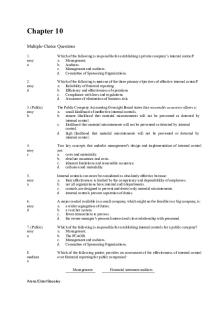
Chapter-10
- 19 Pages
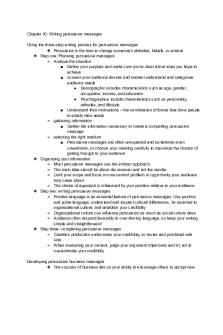
Chapter 10
- 5 Pages
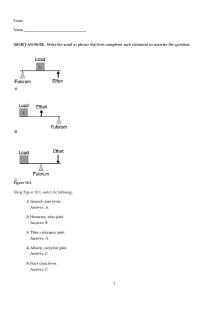
Chapter 10
- 14 Pages

Chapter 10
- 111 Pages
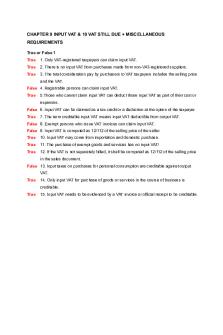
Chapter 10
- 16 Pages
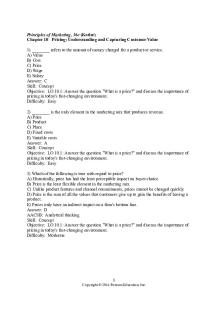
Chapter 10
- 47 Pages
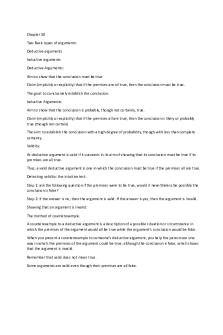
Chapter 10
- 4 Pages
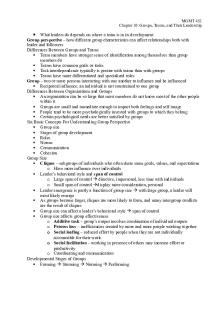
Chapter 10
- 5 Pages
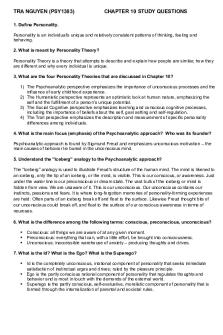
Chapter 10
- 6 Pages

Chapter 10
- 13 Pages

Chapter 10
- 10 Pages

Chapter 10
- 3 Pages

Chapter 10
- 22 Pages
Popular Institutions
- Tinajero National High School - Annex
- Politeknik Caltex Riau
- Yokohama City University
- SGT University
- University of Al-Qadisiyah
- Divine Word College of Vigan
- Techniek College Rotterdam
- Universidade de Santiago
- Universiti Teknologi MARA Cawangan Johor Kampus Pasir Gudang
- Poltekkes Kemenkes Yogyakarta
- Baguio City National High School
- Colegio san marcos
- preparatoria uno
- Centro de Bachillerato Tecnológico Industrial y de Servicios No. 107
- Dalian Maritime University
- Quang Trung Secondary School
- Colegio Tecnológico en Informática
- Corporación Regional de Educación Superior
- Grupo CEDVA
- Dar Al Uloom University
- Centro de Estudios Preuniversitarios de la Universidad Nacional de Ingeniería
- 上智大学
- Aakash International School, Nuna Majara
- San Felipe Neri Catholic School
- Kang Chiao International School - New Taipei City
- Misamis Occidental National High School
- Institución Educativa Escuela Normal Juan Ladrilleros
- Kolehiyo ng Pantukan
- Batanes State College
- Instituto Continental
- Sekolah Menengah Kejuruan Kesehatan Kaltara (Tarakan)
- Colegio de La Inmaculada Concepcion - Cebu
